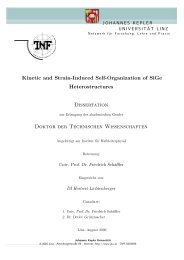Diplomarbeit Diplom-Ingenieur - Institut für Halbleiter
Diplomarbeit Diplom-Ingenieur - Institut für Halbleiter
Diplomarbeit Diplom-Ingenieur - Institut für Halbleiter
You also want an ePaper? Increase the reach of your titles
YUMPU automatically turns print PDFs into web optimized ePapers that Google loves.
26<br />
• Stability of the acceleration and lens currents<br />
• On-axis alignment of the electron beam and the voltage centre of lens<br />
current<br />
• Low spherical aberration coefficient of the objective lens<br />
• Parallel beam for good spatial coherence<br />
• Low energy spread and low chromatic aberration coefficient<br />
• Well aligned stigmators of the intermediate and objective lens to avoid<br />
lens astigmatism<br />
Figure 3.8: (a) Diffraction pattern of a CdTe specimen, recorded along the (110) zone<br />
axis. The most important spots that cause the phase contrast of the lattice planes in the<br />
real image, are indicated. The circle indicates the size of the aperture that was used for<br />
real image recording. (b) Real image that shows phase contrast. The {002} and {220}<br />
diffraction spots are strong for the PbTe rs structure, the {111} are strong for the CdTe<br />
zb structure. The two materials can be distinguished by the corresponding lattice planes<br />
in the real image. The lattice planes are indicated.<br />
3.4.2 Origin of Lattice Fringes<br />
The origin of the lattice fringes are the different phase factor of the scattered beams.<br />
This can be easily shown by the solution of the Howlie - Wehlan equations. The<br />
intensity of the solution is given for the two-beam approximation by [32]<br />
2<br />
2 2<br />
I = ψT<br />
= A + B + 2AB<br />
sin( 2πg′<br />
x − πst)<br />
(3.16)











